|
Oregonbigfoot.com
Newsletter
December 2004 |
Issue: Dec Year: 2004
Editor: Autumn Williams
© 2004 Oregonbigfoot.com
Sign up! It's Free! |
IN THIS ISSUE |
| >> |
EDITOR'S NOTE |
| >> |
NEW BIGFOOT MOVIE! Exclusive interview with "They Call Him Sasquatch" producer David Venghaus, plus a review and movie stills |
| >> |
BIGFOOT NEWS |
| >> |
GEAR SPOTLIGHT
Protect yourself in the woods |
| >> |
KNOWLEDGE IS POWER
Test your tracking know-how |
| >> |
WEBSITE UPDATES/
FEATURED REPORT
Eerie sighting at Multnomah Falls |
| >> |
FINAL THOUGHTS...
Eyewitness Testimony...
Fact or fiction? |
| >> |
FINAL THOUGHTS... What do YOU believe?
|
For Your Collection: |
|
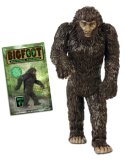
Bigfoot Action Figure
They're big, they're hairy, and they're notoriously elusive! This 7-inch tall, hard plastic Bigfoot Action Figure has stamps on the bottom of its feet and comes with a stamp pad so you can leave mysterious footprints on letters, walls and skin.
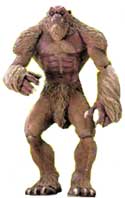
Cryptozoology Action Figure: Bigfoot 
Another one for your collection from Mezco toys.
They're going fast!
Speaking of replicas...
Check this out
An unbelievably LIFELIKE Sasquatch replica from
Nimba Creations!
Eerie, huh?
Money for research?
It's not bigfoot-related, but it's fun. For those of you who are on the computer all the time like I am, this is a great way to make some extra $$$ for being opinionated. <grin> These guys pay $3 for each market research survey you complete. And yes... you can be honest! I guess it's cheaper than hiring locals to come down to the office or paying a telemarketer to call people to ask what they think of this or that ad campaign or product. :)
Check it out
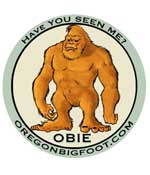
Meet Obie,
Official Mascot of Oregonbigfoot.com!
Thanks to artist Scott Davis once again for his incredible artwork! Add Obie to your bigfoot collection. :) He's available on mugs, mousepads, buttons and more. Also check out the cool new bumper stickers!
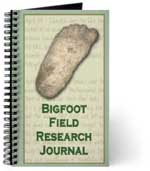
Spiral-bound journal
You asked for it... here it is.
Keep your research notes organized! Take it in the field with you whenever you go...

The Science and Art of Tracking
HIGHLY RECOMMENDED
This book shows how anyone willing to put forth a little effort to go out and practice and get some "dirt time" can learn to follow even the tiniest tracks across the most difficult surfaces. Tom uses a common sense method of tracking that examines a track in terms of "pressure releases." For example: a heavy foot displaces more "dirt" than a lighter foot, a foot traveling fast will displace more "dirt" to the rear of the foot than a foot moving slowly. By measuring the size of these pressure releases one can tell a myriad of things about the creature one is tracking: its size, its direction of travel, its speed of travel and its head position.

Tom Brown's Field Guide to Nature Observation and Tracking (Tom Brown's Field Guides) HIGHLY RECOMMENDED
Hard core tracking tips are blended with instructions on cultivation of the inner silence. Brown gives us practical advice on reading animal tracks, constructing shelters etc. The tips on "Nature Observation" in this field guide are unsurpassed by any other tracking book. TB provides us with priceless descriptions of what happens the moment we enter the forest - that is, how the alarm signal spreads from the birds to mammals and how long it takes for it to subside. The forest he is talking about is a living entity, where everything is connected and where one can plug into the circuits of the information flow by learning to listen to the sounds, by studying the terrain and the wind and by knowing how to camouflage and mask one's smell. The book provides useful info on various types of walking/stalking in the woods.
Do Abominable Snowmen of America Really Exist?
Roger Patterson
There are a couple of copies of this rare book by Roger Patterson (written prior to the famous film)
available right now!
VERY interesting read!
Bigfoot at Bluff Creek
Danny Perez
Bigfoot
B. Ann Slate, Al Berry (HIGHLY RECOMMENDED!)
The evidence for Bigfoot and other man-beasts
Janet Bord
|
|
|
|
| |
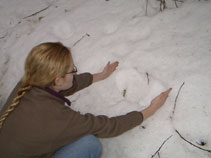
Track in snow near Poopanelly Creek
Clackamas County, Oregon
|
>> Editor's Note:
There's great things afoot in December's newsletter! (pun intended) Be sure to check out the exclusive interview with Dave Venghaus, producer of the the HILARIOUS new Bigfoot movie, "They Call Him Sasquatch".
Speaking of feet, let's look at why this elusive creature is known the world over as "Bigfoot". Surely, everything on a several hundred pound creature is large. Why not "Biglegs" or "Bigface"... or even "Bigbuttocks?"
Certainly it has to do with the giant tracks left behind which are certainly much more common than giant face or derrière prints. <grin> But seriously... who coined the term and how?
It all started back in 1958, when bulldozer operator Jerry Crew was working on a logging operation north of Weitchpec, CA. A local newspaper carried a photograph of Crew holding a plaster cast of a 16" track. The story hit the AP wire and with the quote "Bigfoot, as the Bluff Creek people call the creature, apparently travels only at night", modern-day "Bigfoot" was born.
It's easy to forget that there are other less-sensational names for this creature - names that date back centuries and lend credence to a growing body of historical evidence. Many Native American tribes- all across the country, not just in the Pacific Northwest - have a name for these creatures in their native tongue. Think about that... they actually gave a name to the same species of creature that thousands of people report seeing today. Early Native Americans didn't have CNN or the National Enquirer to help them spread sensationalistic news about "monsters", but they did name and revere ALL wildlife. And while many Native languages, despite proximity, are as different from each other as German is to Mandarin Chinese, the descriptive names given to the "hairy ones" tend to follow along the same lines: Devil, Creek Devil, Wildman, Cannibal Woman, Stick Indian, Ridge Runner... all names descriptive of the fearful behaviors of these giant forest inhabitants.
As a culture, we are desensitized to reality and tend to interpret things in very superficial terms. For instance, when we see a hamburger, we think "beef"... we may even think "cow meat", but how many of us, when we see a field full of cows, salivate and taste that last hamburger we had? Likewise, when we read a report of a Bigfoot sighting, how many of us stop to think about what "bigfoot" really is? "This woman claims to have had an encounter with an actual, living, breathing Giant. A huge, hairy forest creature, more humanlike than any other animal on the planet. An enormous, sentient being that, after having frightened that woman half to death, walks off into the forest and breathes, eats, defecates, procreates and interacts with others of its species, all while we're checking our email, driving our cars, shopping for groceries.. in fact, that same creature is out there, walking around, right this minute..."
The legend lives.
Autumn Williams
Oregonbigfoot.com
Your comments are always welcome.
|
EXCLUSIVE INTERVIEW: David Venghaus, Producer of "They Call Him Sasquatch" |
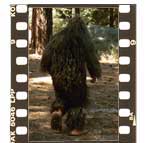
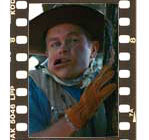
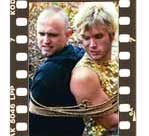
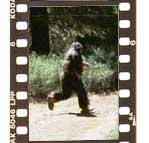
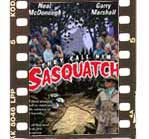 Click thumbnails to enlarge
Click thumbnails to enlarge |
>>
"They
Call Him Sasquatch" (DVD only $11.69 at Amazon.com!)
is David Venghaus' directorial
debut. It's a hysterically funny, tongue-in-cheek look at
Bigfoot research and the people who devote their lives to
the search for a mysterious creature. Venghaus' humor is
silly and delightful - much like a movie-length Saturday
Night Live skit.
I
had a difficult time deciding which was my favorite character...
there's a couple of old-timers who constantly harangue each
other over their differing beliefs, the two hunters who
captured the creature on film (my sides were SPLITTING over
their antics), voluptuous, vacuous Bella and her nerdy husband,
the psychic Sasquatch caller from Ohio (my jaw dropped when
I heard how much her calls sounded like mine!), Buzz Schrott,
the wild-eyed mountain man who can't say anything quietly...
the list goes on, but my favorite has to be Neal McDonough
as Ned Dryer, the gorgeously petulant, overly-charismatic
news anchor who's thrust into the woods with the entire
group. His voice-activated cell-phone gag in the beginning
of the movie had me laughing so hard I could barely breathe.
Having
been on many expeditions and filmed a television series
about Bigfoot, I was taken by the hysterical REALITY of
this little gem... more reality here, in many cases, than
on the set of a "reality" TV show! <grin> It really captures the often-chaotic interactions between
researchers from different walks of life who bring their
beliefs to the field in an attempt to research together.
I screened the movie once, then twice, then a third time
and laughed harder each time. This movie is DEFINITELY one
of my favorites of all time and is sure to become a cult
classic in the research world.
I
interviewed the man behind the magic, David Venghaus, to
find out just what kind of a wonderfully warped person could
come up with such a funny movie...
Autumn:
Let's talk about your background in the filmmaking industry...
David: I started working
in television after college on "The Cosby Show"
in New York. I loved working on that show, not only because
of it being the number one show at the time, but I had an
opportunity to watch and work with one of the greatest entertainers
and comedians in the world, Bill Cosby. I worked as a Production
Assistant for two years before leaving to work in movies.
I worked in New York in films as a P.A. such as Martin Scorcese's
"The Age of Innocence," Robert DeNiro's "A
Bronx Tale," Oliver Stone's "JFK" and many
more films. I then was accepted into the Director's Guild
of America where I've worked as an Assistant Director on
great films like "Forrest Gump", "Natural
Born Killers", "The Other Sister", and most
recently with Steven Spielberg on "A.I.", "Minority
Report", "Catch Me if You Can" and "The
Terminal." I decided that directing was my path which
lead me to "They
Call Him Sasquatch."
Autumn:
What made you decide to do a movie about Bigfoot... or,
Bigfoot researchers, rather?
David: I was on the
internet one day and came upon your website, Oregonbigfoot.com.
I began reading some of the information and stories and
became fascinated with the entire passion for the Sasquatch.
I became most interested in those people who spend their
time in search of the unknown. One of our greatest abilities
has always been to be adventurers. We want to understand
and connect with the unknown and the mysterious. We all
have that in us but only some have the courage to reach
out and explore. I've always loved the concept of the Bigfoot.
I'm embarrassed but humored to tell you that it started
on "The Six Million Dollar Man" when he came on
the Sasquatch. I decided to use that in the movie itself.
I think that all of us like to enjoy ourselves and laugh
with each other. I wanted to find the humor in the search
for something bigger than us.
Autumn: Weren't you afraid you'd offend "serious" researchers? David:
I was afraid that I could offend some when I began this
venture, but I consistently kept in mind that I wanted the
humor to be real and human, not humor that made fun or offended.
I wanted the audience to leave laughing, but laughing by
recognizing a little something in the characters that is
each of us. I wanted to make sure I allowed for the realm
of possibilities to always remain. I do not want or ever
want to belittle the passion of others in their quests.
There is a big difference between laughing with someone
and laughing at someone. I wanted us all to laugh together.
Autumn:
What kind of research did you do prior to filming?
David: The research I did was actually quite extensive. I began
reading every piece of material on the Sasquatch that I
could find. I met with parties that attended expeditions
and I constantly kept up to date with the popular websites
on the Bigfoot, including your own.
Autumn:
Did the cast members have any knowledge of the subject prior
to filming?
David: I made packets of information that I distributed to each
actor and had them do the same. I wanted the audience to
believe that these people were as passionate as those who
really do dedicate parts of their lives in the search. I
wanted the actors to do as much research as possible. I
was proud that each took the time and read the materials.
We spent hours talking about the concepts and information
we gathered. They wanted to get into these lives a little
more.
Autumn:
What about those two crazy hunters? Where on earth did you
find those guys? They're hilarious!
David: My Hunters! I
can't begin to tell you how much we all enjoyed those two.
Jeff Phelps and E. Sean Griffin played these two better
than I could ever have imagined. I was introduced to Jeff
through my producer, Eddie Hunt. Eddie had asked me to read
Jeff for one of the parts. My first thought was...too good
looking. Jeff is very handsome, and I thought that would
play against him. Then he started. He was brilliant. His
timing was dead on. I had him reading with another young
actor who was to play the other hunter. This actor was and
is unbelievably talented, but this is where I realized that
at times it has nothing to do with talent but it's the chemistry
that makes it work. It wasn't working and Jeff and I knew
it. He asked me to come to a comedy show that he did with
his friend E. Sean. I went and was thrown by the small crowd
of three in the place. I couldn't believe it. I thought
I made another mistake. And then they started. They had
me in complete stitches. I found my hunters. At one point
I decided to write the screenplay instead of having the
actors improvise the whole movie. Both Jeff and E. Sean
looked up at me after reading the script and mentioned there
was no dialogue for them. I told them there was just no
way I would ever be able to write as funny as they could
be. I was absolutely correct. They were terrific. I blew
most of the takes because they had me laughing so hard.
My sound man still won't talk to me.
Autumn:
Where did you get the costume?
David:
The Bigfoot costume was designed by a great FX designer
by the name of Douglas White. We were introduced to him
through an associate of mine and he was kind enough to give
us a great deal on the suit. His suit was used in many other
commercials, television and films.
Autumn:
Who played Bigfoot in the movie?
David: Who played Bigfoot? That's a movie in itself. We were up
in the mountains shooting in Big Bear, California. We had
scheduled to shoot Bigfoot over two days. The guy we had
coming up called at the last minute and canceled on us.
I didn't have a large enough guy with us to fit the costume.
My producer, Mike Dieveney went on a search of Big Bear
for a new actor. And he found one. He ran into the nicest
guy in the world, Randy, in a coffee shop. We hired the
almost 7 foot tall man on the spot. He was great. The funniest
moment with Randy was the final scene. It was the last day
of shooting and we were running out of time. I had an entire
scene to shoot. The crew was finishing up lunch and I called
for them all to come up and work. I then heard over one
of the radios that Bigfoot was missing. I then heard that
Randy, in full costume, decided to drive down the mountain
to go to Burger King and scare his friends. I couldn't believe
it. There we were with no Bigfoot. Well, Randy showed up
and I think made a pit stop. Let's say he did a little smoking...
He was a riot. I had a stoned Bigfoot on my hands. Thank
God all he had to do was growl and look menacing. I kept
hearing him laugh when all of the other actors were in their
underwear. I did the sound later.
Autumn: What’s your most memorable moment while shooting the
film?
David:
The most memorable moment for me would have to be the campfire
night. We all had been shooting like crazy and it was night
time. We were sitting around the camp fire and I knew I
had to say something. It was September the 11th, 2002. The
year anniversary. Some of the actors and crew had lost good
friends that day. We had a short and moving tribute in our
own way. A great friend of mine, Dominic Kay, who was six
years old, sang the most incredible song. The entire cast
and crew were in tears. After it was done, Chuck McCann
looked up and said in his brilliant way, "Oh great,
now we have to be funny!" We all cracked up. Chuck
and Warren, our great veterans of the group, had the greatest
attitude and most loving attention to us all.
Autumn:
What are you working on now?
David:
Currently, I am working as an Assistant Director on the
two sequels to "Pirates of the Caribbean" for
Disney. I am also planning my next directing job, "Oklahoma
Skies" which I also wrote. I hope to be shooting this
coming year.
Autumn:
Any plans for a sequel?
David: I would love to do a sequel and you know, I bet I will.
The last day of shooting no one wanted it to end. At one
point the actors came up and said, "Let's start shooting
the sequel now." I wish I could have. I now leave it
to the community of those people who are explorers to give
my inspiration in the quest for the Sasquatch. Good luck
to you all.
Thanks, Dave... We'll need it! <grin>
You
can get your own copy of "They Call Him Sasquatch" from Amazon.com
Visit Echelonent.com
for more information
|
BIGFOOT NEWS |
GEAR SPOTLIGHT :
Preventing animal attacks |
KNOWLEDGE IS POWER:
Learn to Track Properly |
>> Bigfoot? 1977 photo draws researchers hunting fabled man-ape creature
The South Alabamian, November 18, 2004
COFFEEVILLE, Alabama -
"... As I rounded a bend on Highway 69 just south of Coffeeville and started to cross Eberline Mill Creek and go up the hill into the Tattlersville community (many of its residents prefer the better-sounding Union Chapel), I saw an eerie sight. Through the misty fog a figure could be seen on the highway, bent and stooped, with the sun trying to break through the gray in the background. What a great picture, I thought, as I stopped, grabbed my camera and snapped a shot..".
>> more...
>> Researcher: Bigfoot alive, well in southern Oklahoma
A Sulphur man has been working for years to prove the existence of Bigfoot. And now, a piece of rare evidence has surfaced to substantiate his claims.
>> more...
|
>> Trail Cams: Should You Choose
Digital Or 35mm?
There are advantages and drawbacks to both. Digital game cameras allow you to view the pictures in the field... a definite bonus. Imagine having to wait for your film to get developed, only to find that there's nothing of interest on it or you had your camera set too high/low, then having to trek back out to your cam to move it to a better location. With a simple electronic monocular eyepiece, you can preview your shot, view images in the field, and delete those that are taking up space. Digital trail cameras, while more expensive in the short-term, save money on film and developing.
However, 35mm trail cams have a distinct advantage as well... besides, being less expensive, the photographs are much clearer and can be enlarged for analysis.
There are a few different options available for trail cams. On Mysterious Encounters, we used digital Game-Vu cameras. |
>> Listening Devices: An inexpensive, hands-free option
While listening devices like the traditional Bionic Ear with parabolic dish increase hearing capacity greatly and often allow for attachment of a recording device through a 1/8" audio cable, they can be cumbersome to transport and use in the field. So many times, I have struggled with tangled cords, trying to extract my Bionic Ear from the backpack... while straining to listen to a sound that may or may not be worthwhile to record. |
|
WEBSITE UPDATE: |
|
>>Added Zack Hamilton photo on photo gallery page
>>Added new pictures to Peter Oberdorf and Scott Davis pages in the Art Gallery
>>20 new reports published
FEATURED REPORT - Oregonbigfoot.com case file # 00712:
Multnomah county, OR
Date: summer 1986
Nearest town: It was at Multnomah Falls
Nearest road: I-84
Conditions: clear
Time: night 1:00-2:00 am
Location: The exact location was the lower parking lot at Multnomah Falls on I-84. We were parked toward the west end of the lot facing the Columbia River.
My husband, myself and our 11 month old baby were spending the weekend at the Oregon coast. We stayed one night and on the second day decided to just watch the sunset and head back home to Hood River after we ate dinner. It was pretty late by the time we reached Multnomah Falls exit and my husband needed to take a break from driving to get some fresh air. We pulled into the parking lot and there were no other cars at all. We parked our vehicle at the west end of the lower parking lot. Our baby was sleeping in the back seat and he and I got out of the vehicle to stretch our legs and get some air. It was a pleasantly warm evening and very clear out.
Just a few minutes had passed when all of a sudden we heard noise coming from the east end of the lot. We both looked and saw a very large, tall creature coming out of the tunnel where during the day people are walking in and out of constantly. It had to duck down to come through and seemed a bit irritated to have to do so. It came out of the tunnel and stood up tall pivoting to the west and headed our direction. During this entire ordeal, my husband (now ex) and I never spoke a word! Our voices fell silent as we both watched this thing head our way. As it came closer my mind tried to decide what it was. It clearly was not a human, too tall to be that. It was not a bear, as it's arms were long and actually hung to around it's knees at a full stand. It was not a gorilla as it walked like a human and was too big to be a gorilla. Process of elimination led me to the only logical conclusion. It was Bigfoot. Without a doubt.
It was dead silent. You could have heard a pin drop. Wouldn't rational people jump into their vehicle (where their precious child was sleeping)and take the hell off? Well, to this day, I can't explain the fact that we both seemed frozen on our feet and could not move or speak. At this time I recall there was NO FEAR. Absolutely none. Anyway, it approached and as it walked by us (about 20 feet from where we stood) it stopped for just a moment, acknowledged us by turning it's head to look and made a sound(?) and a slightly irritated wave of it's right arm. It then quickly lost interest and continued on it's way heading west in the parking lot. We watched in silence as this huge and obviously dark and hairy creature walked up to a cement wall, firmly planted it's hands on the wall and oh so quickly swept it's feet and legs right on through as it vanished into the dense forest beyond. Then it was gone. This entire incident lasted only minutes I am sure, but living it seemed to be in slow motion. Once the creature hopped the wall my husband and I FINALLY looked at each other wide eyed. All that he said at that moment was "let's get the hell out of here" as we got into our vehicle and took off. It wasn't until this moment that I felt physical fear. I began to tremble uncontrollably. My heart was racing at what we had just witnessed. We drove still in silence for a few minutes and then it seemed that we both at the same moment said to each other "did you see what I just saw?" It was as if we had to confirm it with the other because it was so unbelievable. Yes, we had indeed both seen the same thing, thank God! No one would believe this story. He believed me, and I believed him. He also told me that he had no fear until it was gone, just like me. Not once did we feel threatened by it (though it seemed a bit irritated by something)or did we fear for our sleeping baby in the back seat. Figure that one out! That's my story. I hope you enjoy it. Thank you for giving me a chance to share it. |
FEATURED ARTICLE:
The Native American Link - by Michael Nave |
|
>> Clue to "Gorilla Men" found, may be lost Race of Giants - July 16, 1924
Clallam Indians tell of Eight-Foot Seeahtiks Who Killed Game by Hypnotism - Existence Kept Secret by Other Tribes.
Hoquiam, Washington -- "Mountain Devils discovered at Mount St. Helens near Kelso, are none other than the Seeahtik Tribe," said Jorg Totsgi, Clallam Tribe Editor of The Real American, an Indian national weekly publication in an interview here today.
"Seeahtik" is a Clallam pronunciation. All other tribes pronounce it: "Seeahtkoh."
The Indians of the Northwest have kept the existence of the Seeahtiks a secret. Partly because they know no white man would believe them and the Indian, known for his honesty and truthfulness, does not like to be called a liar, and partly because the northwestern Indian is ashamed of the Seeahtik Tribe, said Totsgi.
"The "Mountain devils" or 'gorillas' who bombarded the prospectors' shack on Mount St. Helens in 1924, according to the description of the miners, are none other than the Seeahtik Tribe with whom every Indian in the Northwest is familiar," said Totsgi.
Were thought to be extinct...
The Seeahtiks were last heard of by the Clallam Indians about 15 years ago, (approx 1899 - 1909) and it was believed by the present day Indians, that they had become extinct. The Seeahtik Tribe also make their home in the heart of the wilderness on Vancouver Island. on the Olympic Range, in particular Mt. St. Helens.
"As described by the Clallam Indians, the Seeahtiks are seven to eight feet tall. They have hairy bodies like the bear. They are great hypnotists, and kill their game by stunning them with hypnotic power. They also have a gift of ventriloquism, throwing their voices at great distances and can imitate any bird in the Northwest. They have a very keen sense of humor," Totsgi added.
"In the past generations they stole many Indian women and Indian babies. They lived entirely in the mountain, coming down to the shores only when they wanted a change of diet. The Quinaults claim they generally came once a year to the Quinault River, about fall. The Clallams say they favored the river area near Brinnon on Hood Canal. After having their fill of fresh salmon, they stole dried salmon from the Indian women.
"The Seeahtik Tribe are harmless if left alone. The Clallam Tribe, however, at one time several generations ago, killed a young man of the Seeahtik Tribe to their everlasting sorrow, for they killed off a whole branch of the Clallam Tribe but one, and he was merely left to tell the tale to the other Clallams up-Sound. The Clallam Indians believed that the Seeahtik Tribe had become extinct.
It is fifteen years since their tracks were last seen and recognized at the Brinnon River. Prior to that time, many Clallam Indians have met and talked with men of this strange tribe for the Seeahtiks talk the strange tongue of the Clallams, which is said to have originated from the bear tongue.
The Quinault Indians, however, claim that Fred Pope of the Quinault Tribe and George Hyasman of the Satsop Tribe were fishing about fifteen miles up the Quinault River in the month of September four years ago (1920) when they were visited by the Seeahtiks. The two Indians had caught a lot of steelhead trout, [sic] which they left in their canoe, and the Seeahtiks stole these.
Henry Napoleon of the Clallam Tribe is the only Indian who was ever invited to the home of the Seeahtik Tribe. It was while Napoleon was visiting relatives on the British Columbia coast about thirty years ago, [that would have made the year roughly 1895] that he met a Seeahtik while hunting. The giant Indian then invited him to their home, which is in the very heart of the wilderness on Vancouver Island. Napolean claims they live in a large cave. He was treated with every courtesy and told some of their secrets. He claims that the giant Indians made themselves invisible by strange medicine that they rub over their bodies and that they were able to cause great fear by hypnotic power and had the gift of ventriloquism, to mimic the owl and throw their voices.
Some Indians claim that during the process of evolution when the Indian was changing from animal to man, the Seeahtik did not fully absorb the tamanaweis or soul-power, and thus he became an anomaly in the process of evolution.
The Indians of the Northwest are of the belief that the "mountain devils" found at Mount St. Helens are the Seeahtik Indians and it is generally their custom to frighten persons who have displeased them by throwing rocks at them.
From the files of Bobbie Short, 1995
http://www.n2.net/prey/bigfoot/legends/seeahtik.htm
BigfootEncounters.com
reprinted with permission
© The Seattle Times, July 16, 1924 |
FINAL THOUGHTS...
|
>> Just the facts, Ma'am...
As a researcher, I've recognized the importance of being able to distinguish between FACT and INTERPRETATION, especially when it comes to anecdotal evidence such as eyewitness accounts. It is a witnesses' job to tell what happened. It is up to me to separate the facts from the witnesses' subjective interpretation of those facts.
For instance: I'm called to the scene of ongoing activity in a rural area. Because the eyewitnesses are experiencing activity around their home on a regular basis, they are excitable and may attribute anything out of the ordinary to the ongoing phenomenon they believe they are experiencing, whether it's related or not. This is very common and doesn't necessarily damage the credibility of the witness... it's simply human nature. I approach the situation knowing this and am careful to listen for fact vs. interpretation while taking notes.
I inquire about recent activity: "Tell me what's been happening lately."
The witness relates: "Well, a bigfoot hit the house last night." (interpretation of events)
"Did anyone see the creature? Were there tracks left behind?" I ask.
"No, there were three loud thumps on the wall at about 3:00 A.M." (statement of fact)
Often, it's possible to get a witness to state "just the facts" with a little careful questioning, as above. A clear, objective investigation mandates getting the most accurate information I can. While thumps on the house may or may not be attributable to a Bigfoot creature, they will be added to the list of potential signs of activity. Later, when reviewing the entire case, the "primary signs" (such as clear sightings, anomalous recorded vocalizations, obvious tracks found and documented, etc.) are separated from the "secondary signs" (broken branches/trees, thumps on the house, indefinite impressions, sounds that may or may not be attributable to other known wildlife, etc.). While these secondary signs in and of themselves do not validate the presence of a creature, they can help establish a pattern of activity. An ongoing scenario with several incidences of primary sign and multiple secondary signs is likely a good location to focus my time and attention. Starting with clear data, however, is crucial - and that means separating the fact from the potentially fictional interpretation.
Autumn Williams
December, 2004 |
| |